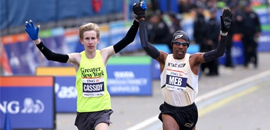by: Mike Cassidy
About 10 miles into Sunday’s ING New York City Marathon, I considered dropping out.
It was comically windy. The pack of four I had been running with from the start had dropped me two miles ago—at a pace that was 10 seconds per mile slower than my goal. My legs felt like crap. I was alone.
But I’ve run enough marathons to know it’s a long race. Sometimes, things turn around. New York is a tough course on a nice day. With a steady 15 mile-per-hour headwind, pace is not a reliable indicator of anything.
Besides, I had trained too well to give up this easily. Workout after workout indicated I was in better shape than when I ran 2:18 two years prior. In the last few months, I’d PR’d in every distance from four miles through half-marathon. But recent PR’s are little consolation when your 11th mile is 5:35 and you’re out of breath.
I couldn’t help but feel it was all slipping away. “Today is not your day,” I thought.
I began to rationalize my unexpected disappointment. It’s been a good season. Be content with that. You still have a couple of years to qualify for the Trials.
Once the negative thoughts begin to creep in, they’re hard to stop. But I had made one commitment to myself before the race, and that was this: stay optimistic. Too many times I have given up on my goals mid-race, only to realize afterwards they were well within my reach, had I maintained my faith.
I thought of my family, my friends, the outpouring of support I had received from the Staten Island running community and my friends throughout New York City.
They were counting on me. Many of them had spent the morning standing in the windy cold, eagerly awaiting my arrival. I owed it to them to keep running. If I was going to drop out, I had to at least make it to the crowds of First Avenue. Until then, no more thinking.
So I settled into a comfortable rhythm. For the first time in my running career, I stopped looking at my watch. One mile at a time.
Little did I know, about a mile up the road, America’s best marathoner, Meb Keflezighi, was going through the same struggles. He had suffered a series of unfortunate injuries in the weeks before the race, first a partial calf tear, then a deep cut on his knee. His training was compromised, and after mixing it up with the leaders in the race’s early going, the lack of preparation began to exact its vicious toll.
But the race leaders were far from my thoughts. As I crossed the halfway mark, I was swallowed by a pack of runners, my race reaching a figurative low point at the Pulaski Bridge’s literal highpoint.
Normally, this would be a terrible thing, more evidence of my floundering goals and more fuel for the negative mental fire.
Then, in an instant, things changed. After 5 miles alone, I had company. The competition rejuvenated my spirit. They also broke the wind. The pace quickened. For the first time all day, I felt like I was racing.
Soon the pack was down to three—Ryan Johns, Toby Spencer, and myself. In the calm of the Queensboro Bridge, I found peace. Before I knew it, we were flying up First Avenue. But I remained cautious, wary my struggles would return. I tucked in. I waited.
Around 19 miles, I went. Easing away from my mid-race saviors, I pushed into the Bronx, one by one picking off the runners who had so effortlessly dropped me back in Brooklyn.
As I made my way over the Madison Avenue Bridge and through Harlem, I found myself in a weird place. After nearly quitting, I was back in a respectable position. My legs had some pop, but I remained unconvinced it would last. I maintained willful ignorance of my pace. And somehow, even though I was headed south, the northerly wind seemed still in my face.
Had a bad race turned good? Would it stay good? On a day like today, what did good even mean?
Read the full article at letsrun.com: FULL ARTICLE

